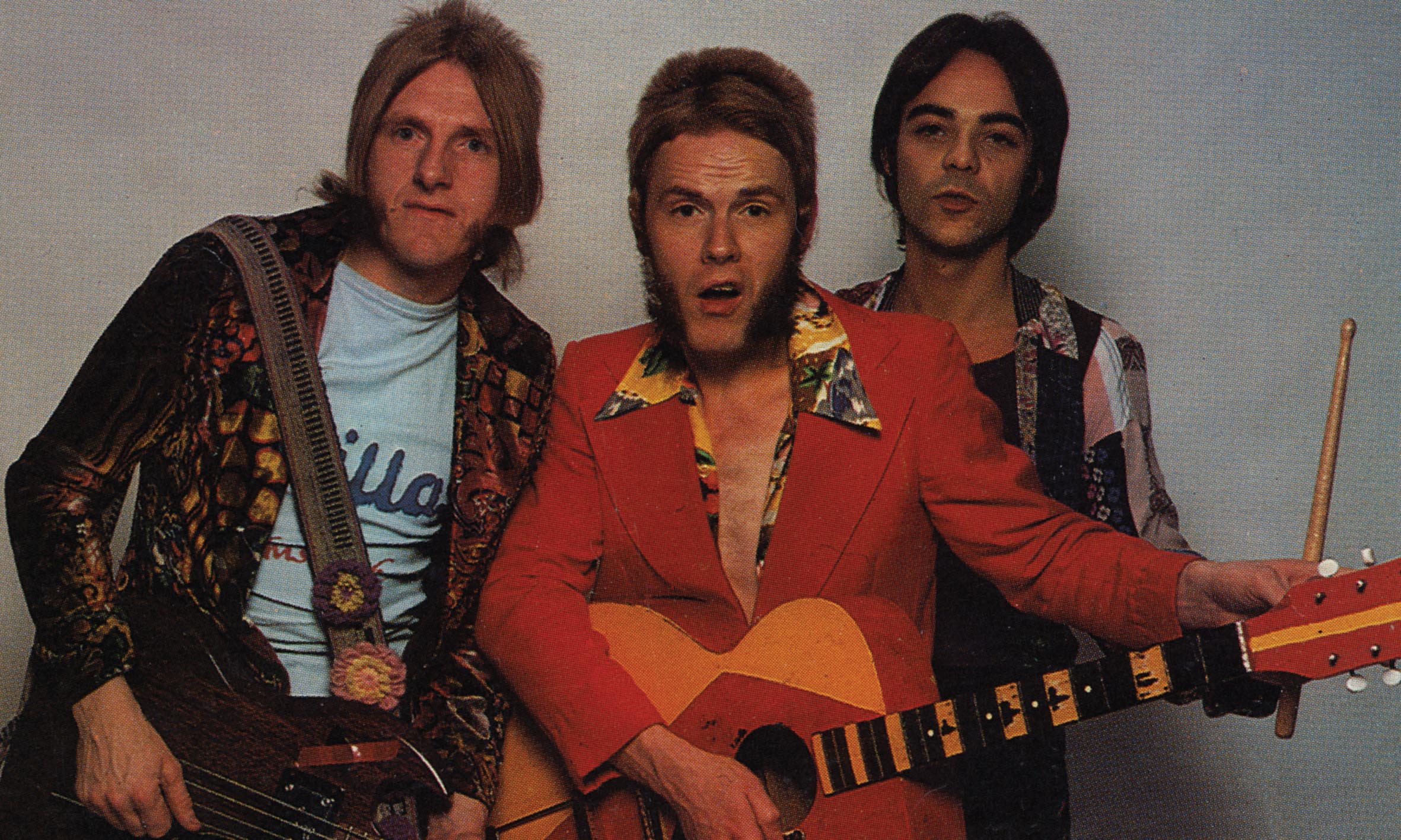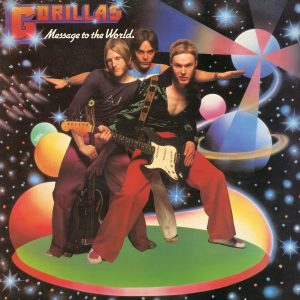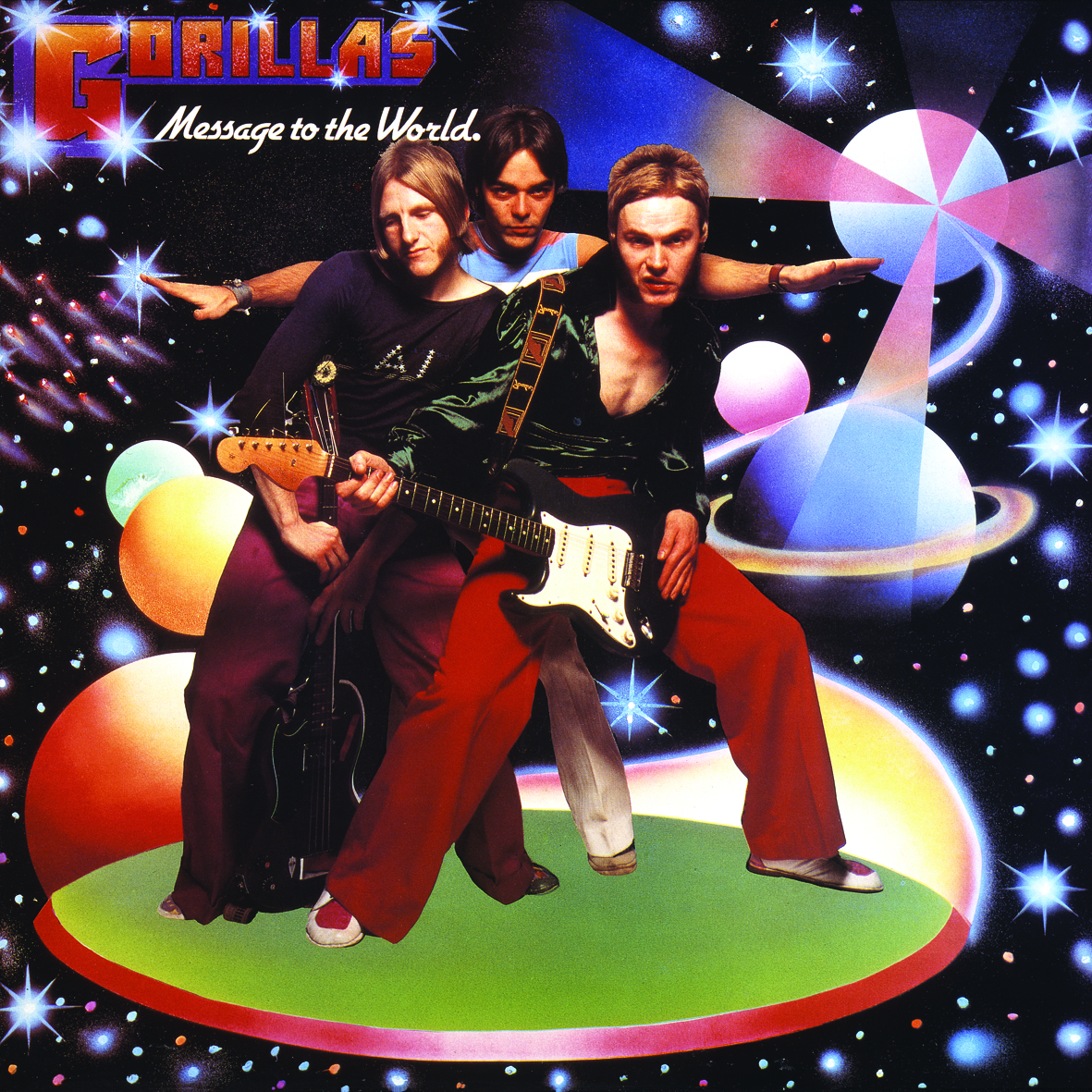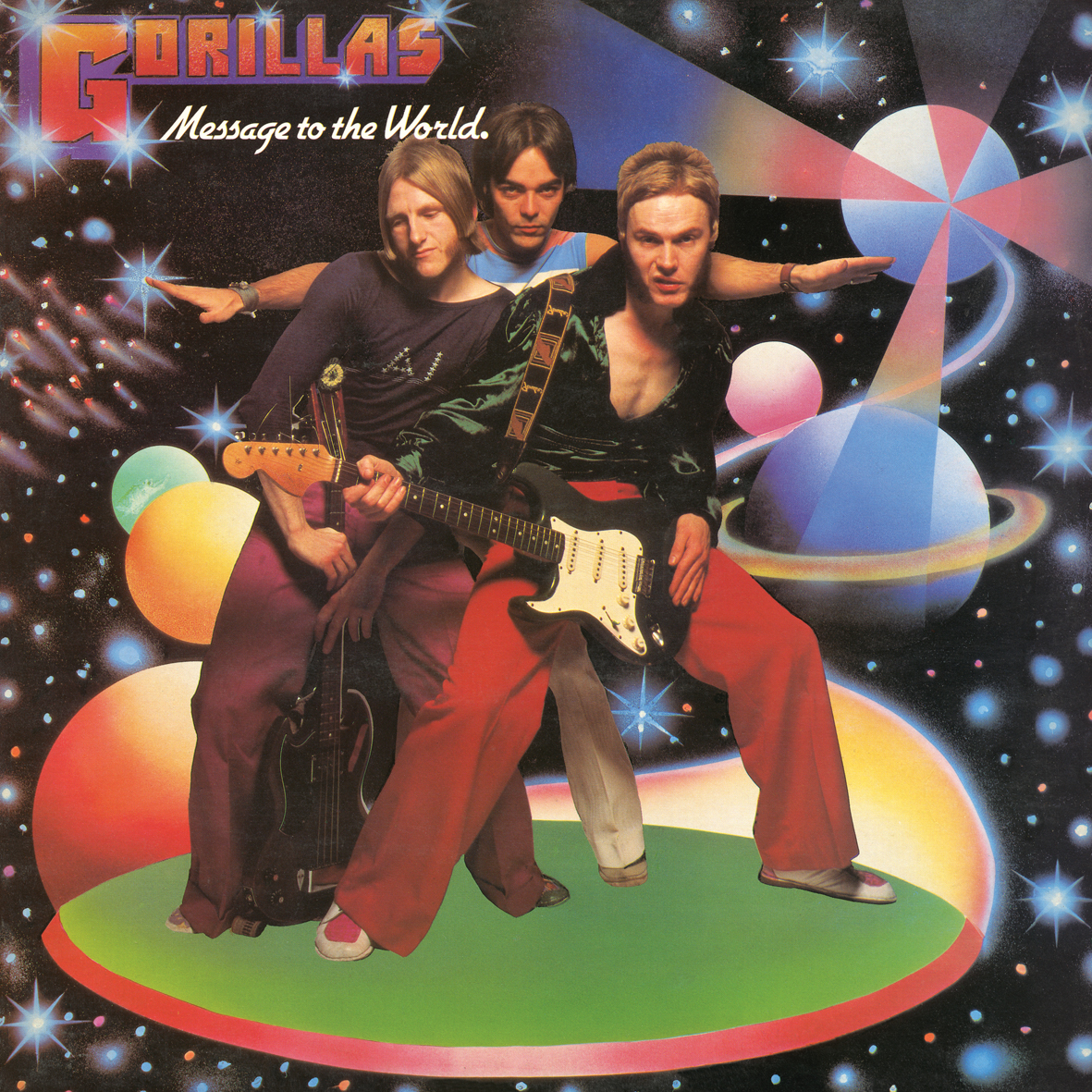JESSE HECTOR & THE GORILLAS – The Story
It is fair to say that the immediate appeal of the incredible Hammersmith Gorillas was triggered primarily by the fascinating sleeves of their first singles. These guys, if anything, deserved total respect simply for being brave enough to look the way they did. Their bizarre display of totally over-the-top hairdos combined with the most incongruous dress sense became an endless source of wonder and speculation for a generation of French fans. Who on Earth were they? Where could they possibly come from?
The sole information available to us was limited to a short column that appeared in an early issue of Rock News. We had been told, in typically distorted fashion by the Parisian fanzine that the band hailed from Scotland (most probably because of the tartan slacks!) despite the rather manifest West London origins their name seemed to suggest. But what the hell! Geography did not matter as much as their fearsome live reputation. Tales of the wildest gigs imaginable had filtered through somehow but no one was prepared for the hammering they were just about to inflict on the unsuspecting Gaelic audiences. On that rainy day of spring 1976, the venerable Salle Franklin in Le Havre was packed with its regular crowd of rowdy dockers and assorted drunken heavies. The locals had come to kick some arse. The others were there to shake some serious action with the Flamin’ Groovies, the well loved heroic mercenaries, still standing in the fight for true rock ‘n’ roll resistance. Little did anyone know that the night would turn into a remake of D-Day. The Hammersmith Gorillas had landed on the Normandy shores unannounced and stormed the stage in bright red and yellow catsuits. Sporting hugely disproportionate sideburns, Jesse Hector, with a bottle-green Stratocaster in hand and his amp cranked up to 11, was rolling and bouncing in all directions, blasting his way through the most violently liberating renditions of “Wild Thing” or “Foxy Lady.” The other two were pounding away a monumental beat in front of an awe-struck, petrified audience. There was definitely a palpable element of genuine fear in the crowd, combined with sheer jubilation as the stupendous energy of the band was not only for real, it also appeared to be dangerously uncontrollable. The familiar rumble of “You Really Got Me” suddenly hit the room at mind shattering volume. The mike stand, which had been tottering precariously during the previous numbers, came crashing down in the wail of feedback, Jessie leaped immediately face down on the floorboards, screaming like a man possessed “Gaarlll! You really got me Nowwrrghh!” He stood up again, brought the show to a climactic deafening finale and shouted good night. It was already over, after only 35 of the most intense minutes of the most intense set of pure and uncompromising rock’n‘roll. The crowd erupted and went berserk, shouting for more, and leaving the Groovies no chance whatsoever. History had just been made and France would simply never forget Jesse Hector and the Hammersmith Gorillas.
 Despite a consistent output of singles and a great LP, the mystery surrounding the band grew thicker as years went by. The ever so faithful French fans who purchased (and still own) every available record, could not provide the band with anything more rewarding than a small “succes d’estime”. The world was too busy being changed forever by Punk Rock to realise what it was missing. It would not be until the early 1990’s when Jesse Hector resurfaced in the London garage scene that the full story of his impressive rocking career would be finally told.
Despite a consistent output of singles and a great LP, the mystery surrounding the band grew thicker as years went by. The ever so faithful French fans who purchased (and still own) every available record, could not provide the band with anything more rewarding than a small “succes d’estime”. The world was too busy being changed forever by Punk Rock to realise what it was missing. It would not be until the early 1990’s when Jesse Hector resurfaced in the London garage scene that the full story of his impressive rocking career would be finally told.
Back in 1976 the Hammersmith Gorillas were actually no novices in the business. Jesse Hector, in particular, had started treaded the London boards as early as 1959. Born and raised in the tough neighbourhood of Kilburn, his blond quaffed hair and imported Leviís jeans quickly granted him a reputation as a particularly energetic rock ‘n’ roll enthusiast. He could be seen playing skiffle in pubs around town and even made several appearances at the legendary 2I’s coffee bar in Soho. An accomplished guitarist by the age of 15 he soon became a regular face in the emerging Mod scene, developing his taste for extravagant outfits and loud amplifiers. He witnessed the first gigs of hot new acts such as John’s Children or the Small Faces who were to become a huge influence on his future musical style.
After a short lived, but spectacular stint with top cult band the Clique, Jesse went on to front increasingly radical and rebellious bands with evocative names like Crushed Butler or Helter Skelter around 1969. Success never quite materialised, as Jesse’s frenetic and insatiable enthusiasm may have appeared too much for some.
However, real recognition finally looked to be forthcoming when Larry Page, famed producer of the Troggs and the Kinks who had worked with Jesse during the Clique days, agreed to take his new band to cut a classic version of “You Really Got Me” at Lansdowne Studios. With the brilliant Alan Butler on bass and Gary Anderson on drums, Jesse Hector had finally found a working formula to deliver his unique concoction of savage vocals and monster guitar riffs, the band was named after the pro-Castro local activist group The Hammersmith Gorillas, who had already been celebrated by the great Third World War around the same time. Jesse’s tendencies for facial hair eccentricities must have inspired the ape-like comparisons. The Hammersmith Gorillas were born and their first single was released in 1974 on Larry Page’s own Penny Farthing label. To this day it remains one of the most spectacular debut record of all times. That single piano note ringing away in the background adds a viciously hypnotic quality to the whole production, and with Punk already lurking on the horizon, it conjures up nearly three decades of British rock in tow and a half minutes of amazing intensity. The flip side, “Leavin’ Home” is equally excellent but the record failed to attract the attention it deserved and Jesse’s life long ambitions to break into the chars were, once again, put on hold. Larry Page also produced two more tracks, which were originally destined to be released as the follow-up single but, with “You Really Got Me” not going anywhere, the project was abandoned. “Eleanor Soapdodge” and “I Live In Style In Maida Vale” are presented here for the first time and show another side of the band’s multiple talents with great Small Faces, Creation-like vocal harmonies and lovely string bending action from Jesse. The songs also reveal Jesse Hector as a unique songwriter with a rather unusual perception of London’s upper classes of the time and their hygiene habits. The tapes were shelved and Ms. Soapdodge was sadly never allowed to join the cast of characters in that great musical, up there in Cockney Heaven, alongside Pool Hall Richard or Lazy Sunday’s Mrs. Jones.
The band ís understandable disenchantment with the lack of response to their best efforts led to the inevitable end of Larry Page’s patronage. Nevertheless, Jesse Hector’s confidence was quickly restored after he caught the attention of Ted Carroll, Dublin-born owner of the Rock On record shop in Golborne Road. Jesse had been a regular customer for a number of years, drawn in by his unlimited passion for vintage rock ‘n’ roll vinyl. He had befriended Ted, who was about to launch Chiswick Records as the first truly independent record label in Britain. A recording session was organised to take place in Dave Robinsonís makeshift studio, above the Hope & Anchor pub in Islington. Roger Armstrong, Ted’s partner in crime at Chiswick, had volunteered as producer and a number of demos were cut, sometime in mid 1975. “Shame Shame Shame” and “Moonshine” are two killer tracks which would have made a brilliant first release but “She’s My Gal,” recorded later at Olympic Studios, was judged more appropriate and became the first single on Chiswick for the Gorillas, who had also decided to shorten their name in the process. Chris Townson of John’s Children played drums on the session, adding a distinct British Beat feel to the overall sound, which is particularly noticeable on the wonderful “Why Wait ‘Til Tomorrow,” perhaps on the the greatest “unfinished” rock ballads ever recorded. Substantial press coverage followed and the band’s live schedule became increasingly busy. The Gorillas had been unequivocally adopted by the punk audiences who loved their ferocious live performances at the Nashville or the Notre Dame Hall. In fact, the Gorillas seemed to act as a missing link between the more traditional, R&B orientated, so-called pub rock scene and the more violent and incisive approach the young punk bands were still trying to achieve. It was, therefore, no surprise to see the Gorillas boarding the tour bus leaving to the south of France in August 1976, along with the Damned, Eddie & The Hotrods and a few others for an appearance at the legendary Mont de Marsan Punk Festival.
The event had been masterminded by French promoter Marc Zermati and promised to be the hottest attraction of the notoriously hottest summer in European memory. Mont de Marsan is your typical sleepy town of southwest France, populated mostly by paratroopers from the nearby army camps, renowned for its bullfights and not very much else. The Gorillas did, of course, cause quite a stir among the locals when they were seen strolling in the small town centre in outrageous chequered gear. Imperishable memories of Jesse and his pals drinking their afternoon tea at the terrace of a bar, packed with a not too friendly looking bunch of red berets, are still vividly present in many a French mind. The bands were due to appear in no specific order in the townís main bullring. The Damned went on early and set the pace for the rest of the day, but the overwhelming heat had left the crowd in an advancing lethargic state. A succession of rather average French bands seemed to drag on far too long and even Dave Vanian’s Nosferatu impersonations on the tiers behind the stage failed to ignite the slowly moving evening. However, everyone present remembers the Gorillas as the most exciting act of the festival. Jesse was determined to stimulate the inert crowd and blow everyone away with another unbeatable performance. The live document presented in this package is a rare testimony of the Gorillas’ extraordinary power and their capacity to work any audience to frenzy. Their head-on approach to the songs, combined with Jesses stage antics, proved totally irresistable and, more than often, impossible to follow.
The Mont de Marsan excursion had been extensively covered by the UK music press and the future looked promising for the Gorillas who released their second single on Chiswick. Produced again by Roger Armstrong, “Gatecrasher” is another sparkling Gorillas party anthem and Jesse’s rallying exhortations to “look out fellas!” continue to be a timeless favourite for many. Fans, however, will always refer to “Gorilla Got Me” as their favourite side. How exactly it came about is not fully known and Jesse claims that a full set of lyrics was originally meant to be recorded. The track sounded so good as an instrumental that it was decided to keep it as it was, with only the right touch of phased vocal effects, added just for good measure. The single fared quite reasonably and even enjoyed a number one spot in the indie charts for a number of weeks. At around the same time, “You Really Got Me” had been reissued by Raw Records and did rather will all around Europe. It was still not enough for Jesse Hector though, who was still craving worldwide recognition and started work on his most ambitious project to date. The highly recommended Message To The World LP was issued on Raw in 1978 and is currently available in an augmented format on Damaged Goods Records (Damgood 49CD). The band kept on touring regularly and were even managed at one point by Rat Scabies of the Damned. They returned to Chiswick one more time in 1981. Their last single, a glorious version of Cliff & The Shadows’ “Move It” failed again to chart and the initial flamboyant spirit of the early days had faded. The tragic death of Alan Butler was also a major blow to the band and Jesse decided to pack it in. He hung up his battered guitar and was not to be heard of again for more than ten years.
The Hammersmith Gorillas never quite made it into the rock ‘n’ roll hall of fame but they did leave an unforgettable mark as one of the most extreme and phenomenal live bands in history. If your travels take you anywhere near the back rooms of some of North London’s pubs, you are advised to check who is due to be playing that night. Chances are that Jesse Hector might be around, ready to liquefy your last brain cells with the loudest and most spectacular rock and roll show you could ever dream to witness. Take cover! Gorilla got me, forever!
PHILIPPE KORPAR-MIGRENNE, June 1998
With special thanks to Gerald Lambert and Jean-Yves Gallo for their
invaluable help.



